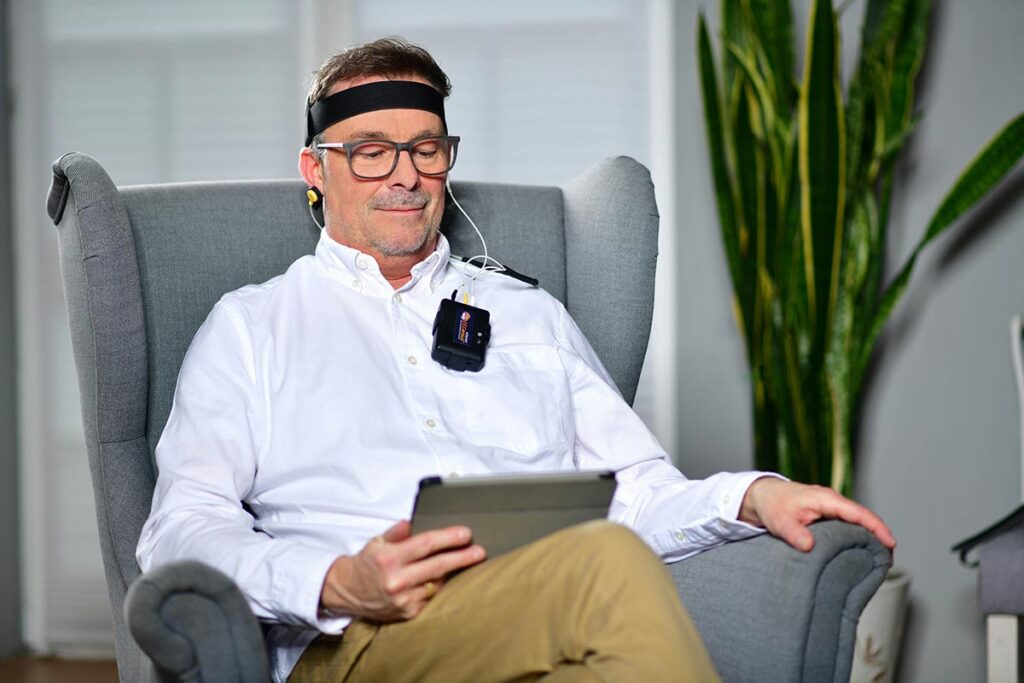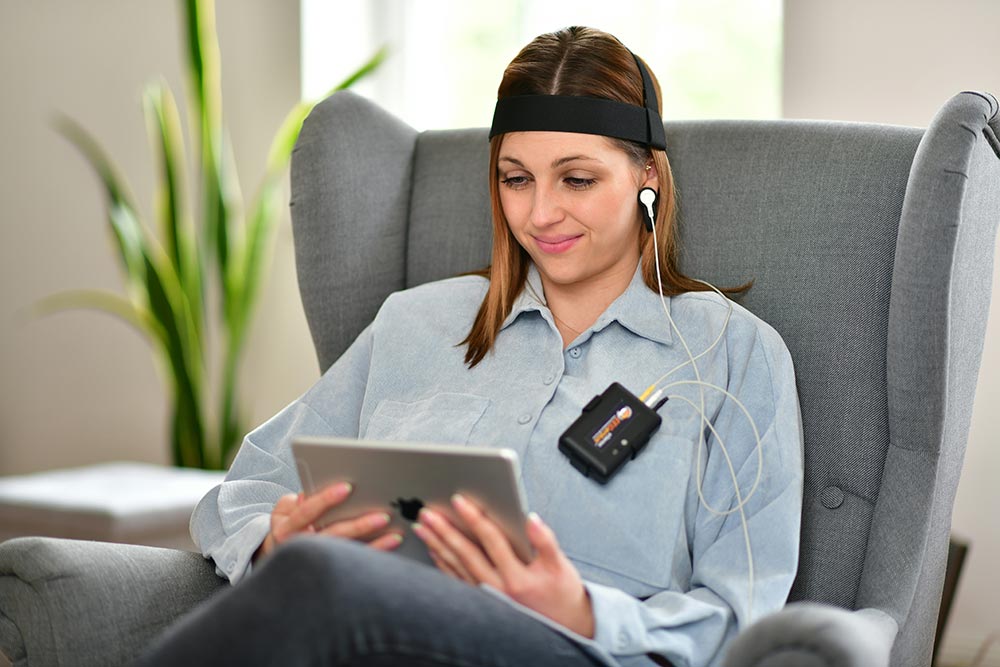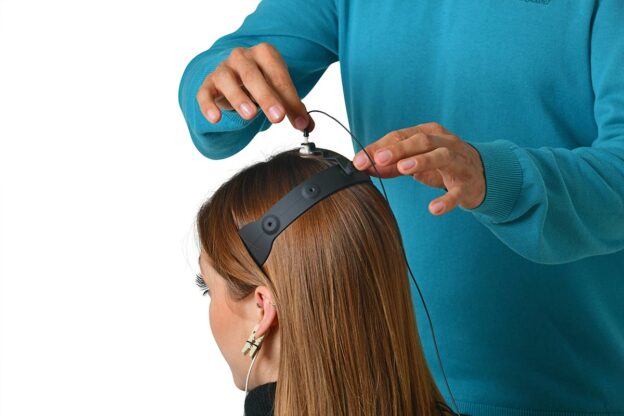What Is Neurofeedback Therapy?
Neurofeedback is an innovative therapy designed to give you real-time feedback on brain reactions, which can help you rewrite unhealthy behaviors and create a more positive way of life. At Stairway Resource Center, we utilize neurofeedback therapy for addiction and mental health as a way to help you understand how you’re responding to treatment so you can create a meaningful recovery plan for lasting success.
The Science of Neurofeedback
Neurofeedback is a type of Electroencephalography (EEG) biofeedback, which is a way we can measure different body functions to make us aware of what’s happening internally so we can then learn how to shift unhealthy behaviors. This therapy teaches self-control of brain functions by measuring different brain waves through sensors placed on your scalp. You may be asked to think about different things like cravings or drug withdrawal, and then you’ll receive an audio or video feedback signal that helps you become aware of positive or negative stimuli in the brain in real-time.
Types of Neurofeedback
The most simple and common form of neurofeedback involves auditory and visual stimuli in real-time. You can then interpret these stimuli and make your own changes to support your recovery goals. Other types of neurofeedback do not require you to take such big action. Instead, they use electromagnetic waves that aim to change your brain activity from within. These types include:
- Electrical surface stimulus that aims to change brain waves
- Low energy neurofeedback (LENS) is a process that delivers a weak electromagnetic signal to the brain
- Low-resolution electromagnetic tomography (LORE-TA), a type that’s very common in addiction treatment, uses 19 points of sensors to gain a better idea of what’s going on in the brain
How Neurofeedback Rewires the Brain for Recovery

Substance abuse and mental health conditions can change the way your brain processes information, leading to psychological and physical dependence characterized by cravings and drug withdrawal. Neurofeedback can help you rewire these brain patterns and change the behaviors that continuously reinforce drug use. This therapy helps you become aware of what’s going on internally so you can make changes as needed. It can also actually help you rewire your brain patterns from within, paving the way for a healthier life of sobriety.
Brainwave Monitoring in Addiction Treatment
At Stairway Resource Center, we utilize neurofeedback as an innovative therapy to help you get to the root of your struggles where they’re actually taking place – in your brain. Brainwave monitoring has been shown to be highly effective for addiction treatment, helping you rewire the way you think, act, and behave when it comes to substance abuse or opioid use disorder. When combined with our evidence-based program rooted in the 12-Step philosophy, brainwave monitoring can help you create profound results in your recovery journey that last.
Why Choose Neurofeedback for Addiction Recovery?
At Stairway Resource Center, we proudly offer unique and innovative therapies like neurofeedback that are perfect for those who have already tried treatment with little to no results. This therapy can help you reach your goals for lasting sobriety by putting the power back into your hands, allowing you to regain confidence, focus, and empowerment along your journey.
Addressing the Neurological Impacts of Substance Abuse
Traditional substance abuse treatment focuses on behavioral health to strengthen your mindset or medication to combat drug withdrawal. Even though these methods are beneficial in their own right, they don’t necessarily address the real neurological impacts of substance abuse. A person who habitually uses drugs or alcohol can rewire the natural reward systems in their brain, forcing them into a dangerous cycle that is only satisfied with more substance abuse.
Restoring Balance to the Brain’s Reward System
Brain-focused therapies like neurofeedback aim to get to the root of addictive behaviors to help you restore balance to the brain’s natural reward system. Neurofeedback actually gives you a clear understanding of this reward system and how it works in real-time. Just as unhealthy habits like substance abuse can take your natural brain functions out of balance, healthier habits and some help from electromagnetic stimuli can help restore them again.
Non-Invasive, Drug-Free Support for Sobriety
Substance use disorder is traditionally treated with medication, but this isn’t always a viable option. Many people who may be resistant to medications or have found low rates of success with them need drug-free options to turn to. Neurofeedback provides an excellent alternative with non-invasive, drug-free support that can support your recovery journey for the long term.
Neurofeedback Therapy at Stairway Resource Center
At Stairway Resource Center, you can discover the power of neurofeedback therapy in a personalized treatment plan that’s tailored to your unique goals and needs. With a philosophy rooted in the 12-Step model, cutting-edge holistic and clinical therapies, and a tight-knit community, our program provides you with one of the most unique and effective treatment options available.
Tailored Neurofeedback Programs Designed for You
Since no two recovery journeys are the same, it’s crucial that treatment be custom-tailored to your individual needs. Neurofeedback at Stairway Resource Center is a highly specialized therapy that literally takes your individual brain into account, helping you understand its behaviors and how you respond to them. When combined with our other cutting-edge therapies and clinical modalities, you can create a highly customized recovery plan that uniquely works for you.
Experts Supporting Every Step of the Journey
During a neurofeedback session, you’ll have expert support to guide you through this simple, non-invasive therapy and help you as you process difficult feelings, thoughts, or emotions that may come up. The addiction recovery journey is not always easy, but at Stairway Resource Center, you can rest assured that you’ll have compassionate, expert guidance every step of the way.
Located in Los Angeles — Healing in a Comfortable, Nurturing Environment
One of our main philosophies at Stairway Resource Center is that recovery is most successful when you have community support and a stable environment. Our state-of-the-art facilities located in Los Angeles provide you with a safe, comfortable, and nurturing environment during your treatment program and even after you’ve completed it. Our patients come from all walks of life and make up a strong community that has come together to collectively support each other and heal together.
How Neurofeedback Makes A Difference
Neurofeedback is a cutting-edge, non-invasive therapy used in substance abuse treatment that can completely shape the way your brain reacts to cravings, triggers, and more. It’s also a powerful tool for many other conditions, including depression, anxiety, and attention deficit hyperactivity disorder (ADHD). This biofeedback modality can vastly improve nearly all areas of your life and help you create a happy, fulfilling, and purpose-filled future.
Reducing Cravings and Triggers for Relapse
Addiction is considered to be a chronic, relapse-prone disease that results from prolonged effects on the brain. Neurofeedback teaches you to monitor these effects so you can learn how to regulate patterns associated with drug use and then retrain your brain to respond to stimuli like triggers and cravings differently.
Enhancing Emotional Regulation and Stress Management
Addiction often goes hand-in-hand with stress, anxiety, and difficult emotions. Neurofeedback can help you regulate these emotions and reduce stress in the same way it works on triggers and cravings. This therapy teaches you to not only observe these feelings without judgment but also helps you regain a sense of control instead of allowing stress and emotions to run the show.
Improving Sleep, Mood, and Overall Cognitive Function
Another powerful benefit of neurofeedback is that it can help you train your brain to produce more calming and relaxing brainwaves. Feeling more relaxed can positively affect every area of your life, improving your sleep patterns and boosting your mood. Neurofeedback also supports overall cognitive function by teaching you how to mindfully and consciously observe your brain activity, boosting your attention span.
What to Expect From Neurofeedback Therapy Sessions
Neurofeedback sessions at Stairway Resource Center are led by highly trained clinicians who will guide you every step of the way. Even though this therapy requires your full attention, it can be highly enjoyable and even feel like you’re playing a game.
Initial Brainwave Assessment and Personalized Treatment Plans
The first step of your neurofeedback session will usually include an electroencephalography scan that maps out your brainwave patterns and defines the initial areas to target for your treatment. This therapy is highly personal, but so is everything we do here at Stairway Resource Center. Each and every patient has their own customized plan of action for neurofeedback therapy as well as their overall treatment, allowing you to discover the best path for your personal success.
Relaxing, Guided Sessions With State-of-the-Art Technology
At Stairway Resource Center, you’ll find innovative therapies offered in-house within our state-of-the-art facility. Utilizing the latest technological advancements and tools like electroencephalography, our neurofeedback sessions give you the most comprehensive and complete results.
Monitoring Progress and Adjusting Treatments for Optimal Results
Neurofeedback therapy at Stairway Resource Center usually consists of daily or weekly sessions that are 30 to 60 minutes long. Of course, each individual’s own course of treatment may be adjusted to suit their needs best. While neurofeedback can help rewire your brain patterns, the real “work” is done through your own consistent behaviors even after therapy is over. Reinforcing habits, routines, and your mindset will go a long way in supporting your recovery.
Who Can Benefit From Neurofeedback Therapy?
Neurofeedback therapy can benefit a wide range of individuals who struggle with a variety of conditions. From addiction to mental health struggles to emotional healing, neurofeedback can change your life in a profound way.
Individuals Struggling With Substance Abuse or Addiction
Substance abuse, alcohol addiction, and opioid use disorder affect millions of Americans each day. Neurofeedback is an innovative therapy that can help those struggling with any of these diseases, giving you a powerful chance to create lasting sobriety. When you’re able to observe unhealthy behaviors in the brain in real-time, you can begin to shift these behaviors and reinforce your brainwaves with positive stimuli instead.
Those Seeking Holistic, Non-Medication-Based Support
Traditional substance abuse treatment has historically consisted of medication and clinical therapies. Unfortunately, this type of treatment isn’t for everyone. Neurofeedback provides a necessary alternative to traditional treatment, giving you a non-invasive option for holistic support.
Patients With Co-Occurring Mental Health Conditions
Addiction often goes hand-in-hand with other co-occurring conditions like anxiety, depression, and attention deficit hyperactivity disorder (ADHD). Neurofeedback can greatly benefit anyone who struggles with these conditions, allowing you to heal them together and pave the way to a brighter, healthier, and happier future.
Get Your Questions Answered Now
Integrating Neurofeedback Into a Comprehensive Recovery Plan

Even though neurofeedback has a multitude of benefits for your recovery journey, it’s only one piece of the puzzle. At Stairway Resource Center, we believe that successful recovery starts with a comprehensive plan that includes a dynamic variety of therapies and modalities that work best for your unique needs.
Combining Neurofeedback With Therapy and Counseling
Neurofeedback may bring up a lot of feelings and tough emotions as you learn how to retrain your brain for sobriety. Combining this modality with therapy and counseling will help you process these emotions and give you the accountability you need to continue moving forward. Expert clinicians at Stairway Resource Center are here to answer your questions, guide you through your treatment, and lend you solid support to reach your goals.
Strengthening Recovery With Relapse Prevention Strategies
Addiction is considered a relapse-prone disease, with relapse rates hovering around 50%. Neurofeedback can help you create new brain behaviors to prevent relapse, but this therapy should be used as just one part of your relapse prevention toolkit. At Stairway Resource Center, we employ the Gorski-CENAPS model for relapse prevention, an approach to recovery that includes 12-Step principles, lifestyle changes, and healthy coping mechanisms. We also have a strong community that will help keep you accountable and provide unyielding support.
Building Emotional Resilience and Mindfulness Skills
A key component of neurofeedback is the fact that it puts the power in your hands. This therapy can help you shift your behaviors where they begin in the brain, but you still have to do your part after the therapy is over by sticking to your new habits, routines, and positive thinking. Mindfulness is a powerful practice that can help you do this by teaching you how to stay focused on the present moment and observe any thoughts as they arise without judgment. This practice can help you build emotional resilience and stay focused on each moment as it unfolds, giving you the confidence you need to continue moving forward on the path to long-term success.
Why Stairway Resource Center Is the Right Choice for Neurofeedback Therapy

At Stairway Resource Center, we offer a wide range of holistic and clinical treatments, allowing you to create your own toolkit for your recovery journey. Neurofeedback is an innovative modality that can strengthen your toolkit and create a strong foundation for sobriety that lasts.
Expertise in Cutting-Edge Treatment Modalities
Here at Stairway Resource Center, our expertise is in offering you the most advanced, cutting-edge therapies that will allow you to heal every dimension of addiction through your mind, body, and soul. Along with neurofeedback, we also offer therapies like eye movement desensitization and reprocessing (EMDR), brainspotting, and transcranial magnetic stimulation (TMS) to give you a full range of options that will support your recovery success.
A Compassionate Team Dedicated to Long-Term Recovery
Many patients who attend Stairway Resource Center have already tried other treatment methods with little to no success. This is why we specialize in long-term recovery with innovative therapies that work and a compassionate team that will support your journey every step of the way.
Personalized Care in a Welcoming Los Angeles Location
Every patient at Stairway Resource Center will work with their team to create a personalized plan that best suits their needs. Even though your treatment is individualized, that doesn’t mean you will be alone in your journey. Our compassionate community in our welcoming Los Angeles location will help you feel safe, seen, and heard.
Ready to Experience the Benefits of Neurofeedback Therapy?
Neurofeedback at Stairway Resource Center can be a life-changing therapy that aids your recovery journey in a profound way. Combined with our wide array of holistic and clinical modalities, plus the 12-Step principles, we believe our program is one of the most unique and innovative options around. Our compassionate team of experts is here to answer your questions, alleviate your concerns, and help you create your own individualized plan for long-term success.
Contact Stairway Resource Center in Los Angeles today to learn how neurofeedback can enhance your journey to lasting recovery. Let’s take the next step together.
FAQs About Neurofeedback Therapy for Addiction Recovery in Los Angeles
FAQs About Neurofeedback Therapy for Addiction Recovery in Los Angeles
What is neurofeedback, and how does it work for addiction recovery?
Neurofeedback is a type of Electroencephalography (EEG) biofeedback that helps you monitor your brainwaves and observe how your brain reacts in real time to negative stimuli like drug cravings. Sensors are placed on your scalp that read brainwave patterns, which are then shown to you in audio or visual form. This non-invasive therapy teaches you how to regulate your negative brainwave patterns and rewire your brain to create healthy new behaviors that support your goals for sobriety.
Is neurofeedback therapy safe and effective for substance abuse?
Neurofeedback is a safe and non-invasive therapy that has been shown to be highly effective for substance abuse. Since addiction changes the way your brain functions, neurotherapy can help you bring your brainwave activity back to a normal, healthy state. Side effects are uncommon, but they may include short-term headaches or tiredness. Other very rare side effects like seizures can occur for those not medically suited for treatment. Be sure to speak to your care team about your full medical history before adding neurofeedback to your recovery plan.
How many neurofeedback sessions are typically needed for results?
At Stairway Resource Center, we offer neurofeedback as daily or weekly sessions with a duration of 30 to 60 minutes each. This may be adjusted depending on your treatment plan. Results vary from person to person, but once you learn a new behavioral pattern and stick to it, further sessions may not be needed. The real work begins with you and your ability to continue sticking to the healthy new patterns even after treatment is over.
Can neurofeedback help with mental health conditions alongside addiction?
Neurofeedback is an excellent therapy for co-occurring disorders of mental health conditions and addiction. This therapy can target a wide range of behaviors that you wish to improve, giving you a comprehensive path to support your overall well-being and creating a strong foundation for long-term recovery success.
Does Stairway Resource Center offer other holistic treatments alongside neurofeedback?
Neurofeedback is not a primary treatment. Instead, it is a powerful tool that can be added to your customized treatment plan. At Stairway Resource Center, we offer a wide range of other holistic treatments that can amplify the effectiveness of neurofeedback and give you the tools you need to lead a happy, healthy, and drug-free life.
Neurofeedback is a powerful therapy that has a wide range of benefits for addiction and mental health. At Stairway Resource Center, we encourage you to explore neurofeedback along with our many other holistic modalities so you can build a comprehensive and customized plan for your long-term recovery success. For more information, give us a call at (888) 450-2701.

